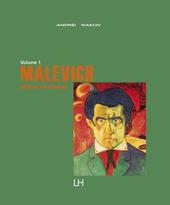
|
Malevich: Painting the Absolute
Hardback
Main Details
| Title |
Malevich: Painting the Absolute
|
| Authors and Contributors |
By (author) Andrei Nakov
|
| Physical Properties |
| Format:Hardback | | Pages:1596 | | Dimensions(mm): Height 285,Width 248 |
|
| Category/Genre | Art and design styles - c 1900 to c 1960
Painting and paintings
Individual artists and art monographs |
|---|
| ISBN/Barcode |
9781848220461
|
| Classifications | Dewey:759.7 |
|---|
| Audience | | Professional & Vocational | |
|---|
| Edition |
New edition
|
| Illustrations |
Includes 361 colour and 790 b&w illustrations
|
|
Publishing Details |
| Publisher |
Lund Humphries Publishers Ltd
|
| Imprint |
Lund Humphries Publishers Ltd
|
| Publication Date |
28 December 2010 |
| Publication Country |
United Kingdom
|
Description
An iconic figure in the history of modern art, the Russian painter Kazimir Malevich (1879-1935) was the creator of Suprematism, best known for his emblematic Black Square (1915). Censored in Russia for many years, his revolutionary writings were only recognised at the end of the twentieth century, initially in Western Europe. Similarly, much of his work remained unknown until the fall of Communism; little studied, the life and work of this painter remain shrouded in an aura of mystery. Andrei Nakov's monumental 4-volume study of this prophetic artist is founded on many decades of research in Russia, Western Europe and the US. The author has uncovered many previously unknown documents, and sheds a new light on Malevich's pivotal role in the development of modern art, offering a radically new interpretation of a fascinating artist. What results is the most detailed and comprehensive analysis of Malevich's complete oeuvre available in English, and an essential reference companion to the Malevich catalogue raisonne. Volume 1 Impressionism and Symbolism are the starting points of the Polish-born Russian painter Kazimir Malevich's avant-garde trajectory. The artist's passion for Gauguin and Cezanne, and his subsequent involvement with Cubism and Futurism, enabled him to lay the foundations of a powerful oeuvre bolstered by an unrivalled sensitivity for colour. Theory and practice, theatrical and literary experiences, paved the way for his uniquely original venture into 'transrational' creation. By exploding the coherence of traditional 'realist' representation, and thus the meaning of visual forms, Malevich pioneered a new approach to art. In the spring of 1915, moving courageously beyond the boundaries of traditional mimesis, he ventured into non-objective painting. Volume 2 Starting with Malevich's revolutionary Quadrilateral ('Black Square') of 1915, which his contemporaries experienced as a veritable earthquake, Suprematism developed vertiginously, attaining the maximal intensity of pure colour barely three years later. In the summer of 1918 the so-called colourless phase of Suprematism culminated in White Square, which marked a major painterly and philosophical turning point in the handling of colour as energy. The artist's white-on-white compositions at the Non-objective Creation and Suprematist exhibition in spring 1919 provoked the anger of his fellow non-objectivists. Motivated by philosophical considerations, his temporary abandonment of painting, which he declared 'obsolete', sounded the death knell of abstract art in Russia. Malevich's impulse to move beyond painting remains little understood even today; at the time it meant the end of any hope of his pursuing a career and making a permanent place for Suprematism in Moscow. Volume 3 Introducing Suprematism to the sphere of everyday life, Malevich created highly original architectonic works in the early 1920s, while concurrently producing an important body of theoretical writings constantly marked by philosophical preoccupations. In the teeth of increasing social adversity he turned to foreign venues. An exhibition in Berlin in 1927 opened the doors of the Bauhaus and brought him to the attention of Western European and, not long after, North American viewers. However, the idealism of his art proved anathema to the totalitarian authorities in his homeland. On returning to Leningrad he was immediately jailed. Although released he was imprisoned again, far more traumatically, in 1930, as a result of which he began to explore new figurative approaches. Endeavouring to produce images of the 'new man', he laid the foundations of his post-Suprematist figurative painting, which reconsiders symbolic values from the standpoint of his non-objective experience. Blacklisted, he suffered severe material deprivations and social ostracism, which soon made it impossible for him to continue painting. He died of cancer in 1935, aged barely 56. In addition to a visual oeuvre of stunning intensity, he left behind an as yet partly unpublished and untranslated corpus of highly original writings, the gist of which English-language readers will discover here. Volume 4 A prolific writer and fervent polemicist, Malevich wrote throughout his life and produced a vast body of texts. His Futurist and Suprematist manifestos, theoretical and polemical articles, aesthetic treatises and voluminous correspondence are duly listed in this volume, along with an exhaustive bibliography of publications devoted to his work. In addition to a generously illustrated and detailed summary of Malevich's life, this volume includes a searching study of his visual techniques and an addendum to the 2002 Catalogue Raisonne of his paintings, architectonic constructions and graphic work.
Author Biography
Andrei Nakov is the leading world expert on the work of Kazimir Malevich and the Russian avant garde. He is the author of the Malevich catalogue raisonne (2002), an extensive critical anthology of the writings of Malevich (1975), and L'Avant-garde Russe (1984). Kazimir Malewicz: Le Peintre Absolu (the French edition of the present book) was awarded a prize in 2007 by the Academie francaise des Beaux-Arts. He has organised numerous exhibitions on Dada, Constructivism and abstract art, including the Tate Gallery's Malevich exhibition in 1976.
Reviews'...readers will find much of interest in this examination of Malevich's creativity and its multiple levels of thought...The many illustrations are lavishly reproduced...the encyclopedic approach presented in this set of books is especially well suited for research libraries... Recommended. Graduate students and researchers/faculty.' Choice '...beautifully produced four-volume set on the life and work of early abstractionist, Kazimir Malevich.' Cassone
|